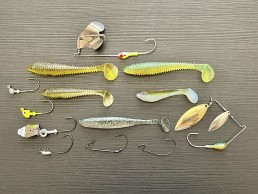The ‘Adjustable’ Search Bait
SHARE THIS POST
Bank fishing specialist Dan Brozowski uses different rigs to present swimbaits at all depths.
A formidable portion of your angling time from the bank is spent attempting to locate active fish. There are no electronics to rely on as you wander the banks, no locators, no flashers and no forward-facing sonar (FFS). Yes, there are a few castable locators, but they require an extra rod set up to work efficiently while you’re making casts, and I’ve found them to be a little distracting on my outings. So, how do you locate active fish without all the gadgets? Search baits!
Search baits are primarily thought of as a bass fishing tactic, but by adjusting the size and type of lure, you can use a variety of baits to search for any species. From bluegills to muskies, locating active fish has always been the toughest, in my opinion, process in the successful bank angling puzzle. If I know fish are in a particular area, I’m relatively certain I can find some way to make them bite. Tracking down the active fish, minus the use of electronics, comes down to one technique for me: Searching the waters from top to bottom, using faster-moving baits and rigs and the ability to cover unusual amounts of water during the process.
As mentioned earlier, search baits are the choice no matter what species you pursue. For this writing, our main focus will be directed towards te most sought-after gamefish—primarily bass, walleyes and maybe a few pike—and not so much panfish. I’ll share some search techniques for them in a future segment.
There is no official search bait per se. A search bait can be any bait/lure that can be worked efficiently through various depths to locate active fish in those depth ranges. When I am in search mode, I normally start at the surface and work my way to the bottom; therefore, baits that worked those depths effectively were always my choice. Originally, crankbaits were always my first choices as ultimate search baits, as they covered a whole lot of water and depths from top to bottom. But they did have their limits: Summer weeds wreaked havoc on the dangling trebles, and while they could cover most of the depths, as the weeds became prominent, their effectives would drop off.
I bounced around between baits looking for that ultimate search bait that could cover various depths and water conditions effectively. Lipless cranks, spinnerbaits, vibrating jigs, to name a few, all had their moments, but still fell a little short, having their own weaknesses in various conditions.
Are you enjoying this post?
You can be among the first to get the latest info on where to go, what to use and how to use it!
One day, I had one of those aha moments while re-rigging a paddletail-type swimbait from a jig head to a swimbait hook, making the bait weedless. I started wondering how many ways I could rig the typical paddle tail swim bait for various conditions. From that point forward, I realized that by simply adjusting how the soft bait was rigged to the “hardware,” I could create a multitude of search presentations from just one style of bait offering.
So, I started from the top, working down from the surface. I began installing swimbaits on skirtless buzzbaits, and skirtless spinners, too. I could cover the top layers of water with these baits very efficiently. I would also Texas rig (without weight) these type swim baits and creep them along the top of heavy weed growth, working them just as I would a frog or toad\; bass responded favorably. Swimbait jig heads and plain, bladed jigs with no skirt allowed me to cover much of the same ranges that were once relegated to the crankbait. Now, depending on retrieve speed, I could cover all depths. Weighted swimbait hooks allowed me to work the bait through various weed-prone depths, effectively creating a weedless presentation.
As you can see, by simply changing the “hardware” on your typical swimbait and tweaking the sizes and colors to fit your situation, you can create a very “adjustable” searchbait system to locate active fish. Using fewer baits means less tackle to haul as you meander down the banks during the heat of the summer!
For more insight and tips for fishing throughout the year, check out the articles in every issue of MidWest Outdoors, available by subscribing on our website.
MWO
SHARE THIS POST
You may also like...
Nothing found.
Did you enjoy this post?
You can be among the first to get the latest info on where to go, what to use and how to use it!
Dan Brozowski
Passion for angling drives Dan Brozowski to the water’s edge virtually any chance he gets. Although passion cannot be measured, weighed, or recorded, it can be shared. He does this through his writing and while on the water. If you have any questions or comments for Dan, you may contact him at: onthebank@att.net.
